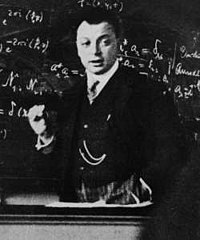
Photo from wikipedia
The Pauli exclusion principle (PEP) can be considered from two aspects. First, it asserts that particles that have half-integer spin (fermions) are described by antisymmetric wave functions, and particles that… Click to show full abstract
The Pauli exclusion principle (PEP) can be considered from two aspects. First, it asserts that particles that have half-integer spin (fermions) are described by antisymmetric wave functions, and particles that have integer spin (bosons) are described by symmetric wave functions. It is called spin-statistics connection (SSC). The physical reasons why SSC exists are still unknown. On the other hand, PEP is not reduced to SSC and can be consider from another aspect, according to it, the permutation symmetry of the total wave function can be only of two types: symmetric or antisymmetric. They both belong to one-dimensional representations of the permutation group, while other types of permutation symmetry are forbidden. However, the solution of the Schrödinger equation may have any permutation symmetry. We analyze this second aspect of PEP and demonstrate that proofs of PEP in some wide-spread textbooks on quantum mechanics, basing on the indistinguishability principle, are incorrect. The indistinguishability principle is insensitive to the permutation symmetry of wave function. So, it cannot be used as a criterion for the PEP verification. However, as follows from our analysis of possible scenarios, the permission of states with permutation symmetry more general than symmetric and antisymmetric leads to contradictions with the concepts of particle identity and their independence. Thus, the existence in our Nature particles only in symmetric and antisymmetric permutation states is not accidental, since all symmetry options for the total wave function, except the antisymmetric and symmetric, cannot be realized. From this an important conclusion follows, we may not expect that in future some unknown elementary particles that are not fermions or bosons can be discovered.
Journal Title: Symmetry
Year Published: 2021
Link to full text (if available)
Share on Social Media: Sign Up to like & get
recommendations!